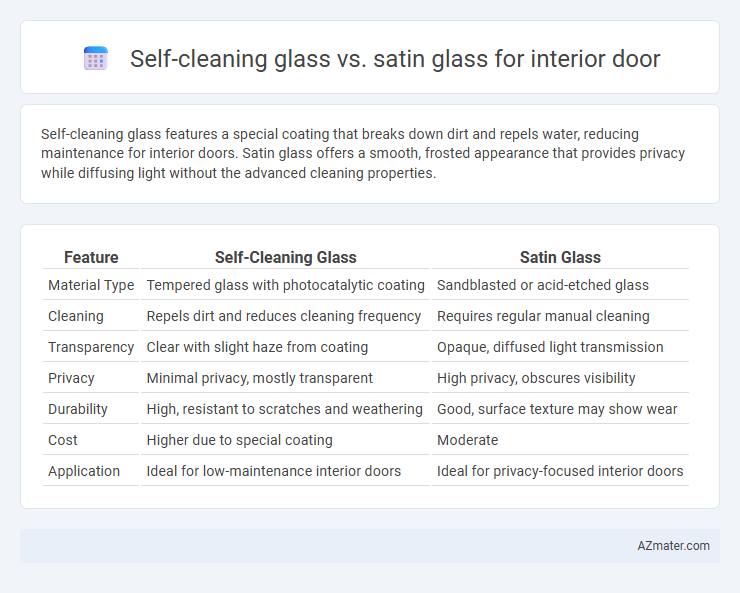Self-cleaning glass features a special coating that breaks down dirt and repels water, reducing maintenance for interior doors. Satin glass offers a smooth, frosted appearance that provides privacy while diffusing light without the advanced cleaning properties.
Table of Comparison
| Feature | Self-Cleaning Glass | Satin Glass |
|---|---|---|
| Material Type | Tempered glass with photocatalytic coating | Sandblasted or acid-etched glass |
| Cleaning | Repels dirt and reduces cleaning frequency | Requires regular manual cleaning |
| Transparency | Clear with slight haze from coating | Opaque, diffused light transmission |
| Privacy | Minimal privacy, mostly transparent | High privacy, obscures visibility |
| Durability | High, resistant to scratches and weathering | Good, surface texture may show wear |
| Cost | Higher due to special coating | Moderate |
| Application | Ideal for low-maintenance interior doors | Ideal for privacy-focused interior doors |
Introduction to Self-Cleaning Glass and Satin Glass
Self-cleaning glass for interior doors features a special coating that breaks down organic dirt and uses rain or water to wash away debris, reducing maintenance efforts and enhancing transparency. Satin glass offers a frosted, opaque finish creating privacy while allowing light diffusion, making it ideal for spaces requiring discretion without sacrificing natural light. Both materials serve functional and aesthetic roles, with self-cleaning glass emphasizing low maintenance and satin glass focusing on privacy and style.
How Self-Cleaning Glass Works in Interior Doors
Self-cleaning glass in interior doors uses a photocatalytic coating that activates under sunlight or artificial UV light to break down organic dirt on the surface. This coating also allows rain or moisture to spread evenly, washing away residue and preventing streaks or spots. In contrast, satin glass lacks these properties and requires manual cleaning to maintain clarity and aesthetics.
Key Features of Satin Glass for Interior Use
Satin glass for interior doors offers a smooth, frosted appearance that enhances privacy while allowing natural light to filter through, making it ideal for spaces like bathrooms or offices. Its fine, matte finish resists fingerprints and smudges better than clear or self-cleaning glass, requiring minimal upkeep. Unlike self-cleaning glass, which relies on photocatalytic coatings to break down dirt, satin glass provides consistent diffusion and a subtle aesthetic that complements modern interior design.
Aesthetic Appeal: Self-Cleaning vs Satin Glass
Self-cleaning glass offers a sleek, crystal-clear finish that enhances interior door aesthetics with its glossy, reflective surface, maintaining a pristine look over time. Satin glass provides a soft, matte appearance that diffuses light gently, creating a subtle, elegant ambiance while concealing fingerprints and smudges effectively. Choosing between the two depends on whether a modern, high-shine style or a muted, sophisticated texture best complements the interior design.
Privacy Levels: Which Glass Is Better?
Self-cleaning glass offers moderate privacy with a clear surface coated to resist dirt and grime, making it more suitable for areas where visibility is desired but cleanliness is a priority. Satin glass provides higher privacy levels due to its frosted, translucent finish that obscures detailed views while still allowing natural light to pass through, ideal for interior doors in bathrooms or bedrooms. For maximum privacy without sacrificing light diffusion, satin glass outperforms self-cleaning glass in sealing personal spaces from direct visibility.
Maintenance and Cleaning Requirements
Self-cleaning glass for interior doors utilizes a special coating that breaks down dirt and repels water, significantly reducing the frequency and effort required for cleaning compared to satin glass. Satin glass, with its frosted texture, tends to accumulate fingerprints and smudges more visibly, demanding regular wiping with gentle cleaners to maintain its appearance. Choosing self-cleaning glass enhances convenience and lowers maintenance costs, especially in high-traffic areas prone to dust and grime accumulation.
Durability and Longevity Comparison
Self-cleaning glass offers enhanced durability due to its hydrophobic and photocatalytic coatings, which reduce dirt accumulation and minimize the need for frequent cleaning, extending its lifespan in interior door applications. Satin glass, while aesthetically pleasing with its frosted texture, is more prone to surface scratches and requires careful maintenance to preserve its finish over time. Comparing longevity, self-cleaning glass generally outperforms satin glass by maintaining clarity and structural integrity longer, making it a practical choice for interior doors where durability is prioritized.
Cost Analysis: Self-Cleaning vs Satin Glass
Self-cleaning glass for interior doors typically incurs higher upfront costs due to advanced nanocoating technology that reduces maintenance expenses over time. Satin glass, while more affordable initially, may require frequent cleaning and potential replacements to maintain aesthetic quality, increasing long-term costs. Evaluating total expenditure favors self-cleaning glass when considering labor and product savings across a multi-year period.
Best Applications for Each Glass Type
Self-cleaning glass is ideal for interior doors in high-traffic areas where maintenance time is limited, such as office entrances and kitchens, due to its ability to break down organic dirt and minimize cleaning needs. Satin glass, with its frosted, non-reflective surface, is best suited for privacy-focused applications like bathroom doors and conference rooms, offering diffused light while obscuring visibility. For optimal interior design, choose self-cleaning glass when durability and low upkeep are priorities, and satin glass when privacy and subtle elegance are required.
Choosing the Right Glass for Your Interior Door
Self-cleaning glass for interior doors features a special coating that breaks down dirt and repels water, reducing maintenance and keeping surfaces clear with less effort. Satin glass offers a frosted, translucent finish that ensures privacy while allowing light diffusion, ideal for rooms requiring separation without complete opacity. Selecting between self-cleaning and satin glass depends on balancing the need for easy upkeep against desired light transmission and privacy levels in your interior spaces.

Infographic: Self-cleaning glass vs Satin glass for Interior door
 azmater.com
azmater.com